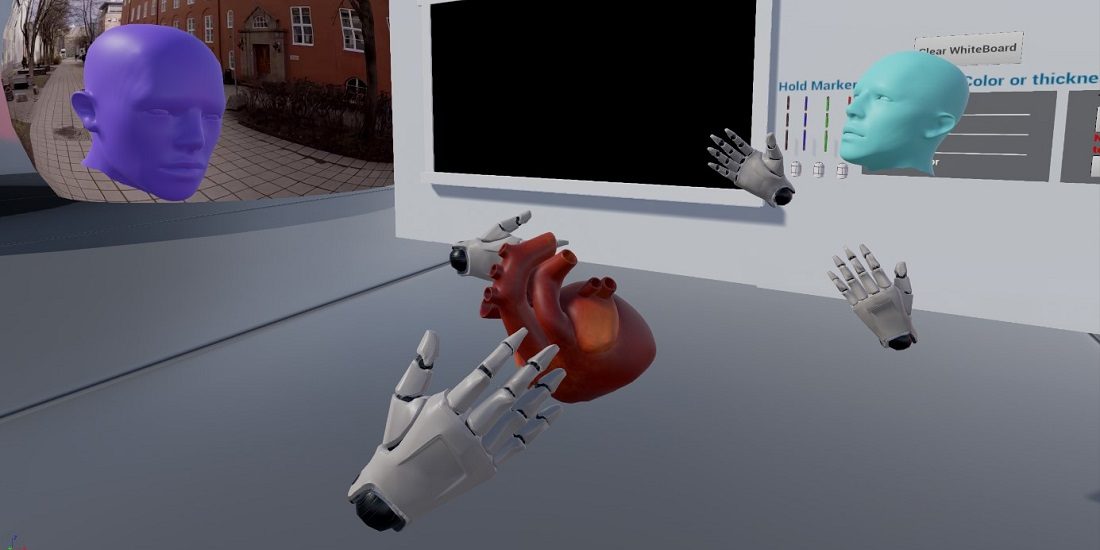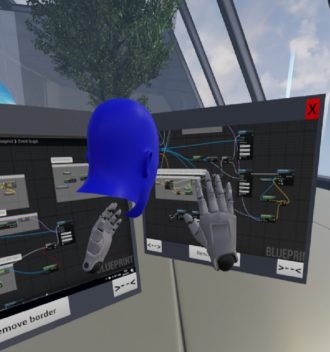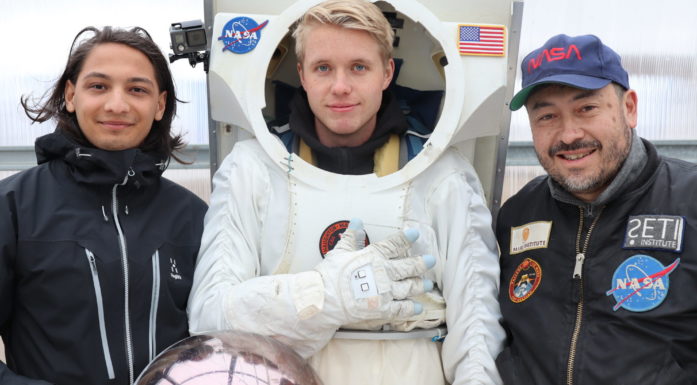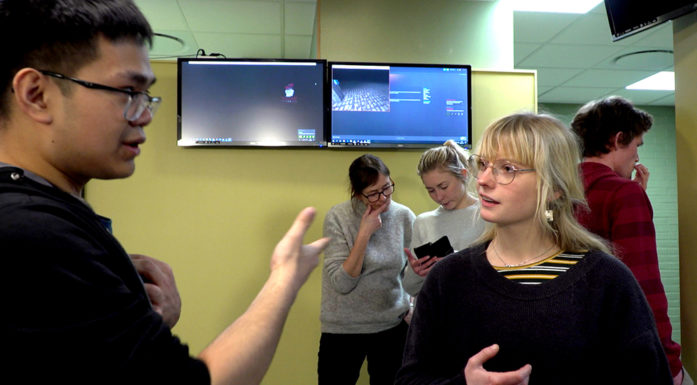Sharing a chalkboard from 300 km away
Nicklas is 300 kilometres away. He waves and hands you a piece of chalk. You take it from him and draw on the board.
VIRTUAL REALITY (VR): Gemini is visiting NTNU’s Dragvoll campus in Trondheim, and master’s student Nicklas Nilsen is sitting in the town of Gjøvik. Right now he consists of a green face and two gesturing hands. He shows us how we can collaborate using virtual reality.
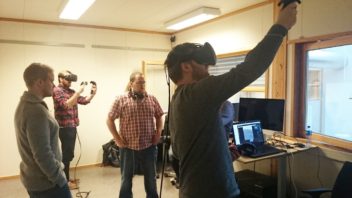
Two EiT groups in Trondheim work together with the EiT students in Gjøvik using VR. Photo: Experts in Teamwork
Our 3D helmets are on, the earplugs are in and with the help of two handles, we can move around the room and interact with the various objects contained in it. We can’t lift that cow, but we can throw the dice across the floor. The chalk works the way it’s supposed to, and we try to avoid hitting our heads on that pole.
After a few minutes, we thank each other, take off the VR helmets and return to looking at white walls. We are in a lab with a long name: the Lifelong Learning VR-lab, which is housed in NTNU’s Department of Education and Lifelong Learning (IPL).
Cooperation in three cities
The work at NTNU is linked to Experts in Teamwork (EiT), a course where students learn to collaborate and build their interdisciplinary teamwork skills.
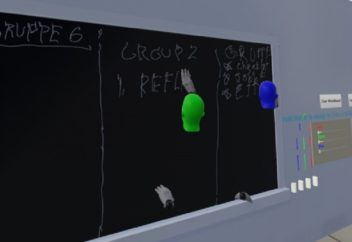
EiT check-in: Planning group activities in Trondheim and Gjøvik on the virtual chalkboard. Illustration: Experts in Teamwork
“We’ll be using virtual reality in future Experts in Teamwork classes. We already have three EiT groups in Trondheim and Gjøvik who’ve worked together in VR. One of the groups has developed a VR laser game that will be an “icebreaker” for NTNU students who meet in VR, so they can also have a social and fun time,” says Associate Professor Ekaterina Prasolova-Førland at IPL.
Prasøpva-Førland and her partners from Gløshaugen, Ålesund and Gjøvik campuses has received NOK 1 million from the Property Division at NTNU to establish innovative learning arenas – both physical and virtual – in order to strengthen collaboration across the NTNU campuses.
The importance of this cooperation became particularly relevant when NTNU expanded to include the campuses in Gjøvik, Ålesund and several places in Trondheim. Now people in three cities will need to be able to work together as well as possible, and this is where the collaborative VR simulator comes in.
So, it sounds fun, but can it be used for anything?
All kinds of tools
“The students in EiT have already used the virtual learning arena to collaborate with the students in Gjøvik – they’ve brainstormed on the board and shared documents,” says Prasolova-Førland.
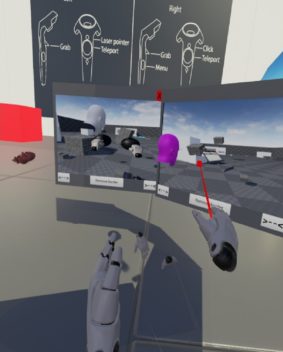
EiT check-out: Review of the day’s results between the groups in Trondheim and Gjøvik. Illustration: Experts in Teamwork
One of the groups has developed a building kit that enables them to work together to develop 3D models for teaching purposes, like 3D molecules.
“It’s clear that some types of collaboration are better suited to other tools, but students are more likely to be socially engaged in VR,” says Prasolova-Førland. “Our task is to find the formula or recipe for optimal ways to collaborate between campuses. As an example, X shares VR and Y shares other tools like Skype and Google docs and Z shares old-fashioned face-to-face meetings.”
(X * VR + Y * other tools + Z * old-fashioned meetings)
She says virtual reality has to be part of the solution. This technology is still relatively new, and it holds so many possibilities for the future. Another solution is AR – augmented reality – which combines data from the physical world with virtual data and provides more information.
- You might also like: Jump in the sea and swim with salmon
Great potential
Demos show potential scenarios, like where you can sit on the seabed and watch a real whale swim by, or games like Until Dawn: Rush of Blood that can terrify the most ardent rollercoaster fans. It’s just a question of time. And financing. And the will to try out new methods.
Giant companies like Facebook, Microsoft, Ford and Samsung are focusing heavily on the new technology. For example, Samsung uses virtual reality to train new factory employees.

Mathworld: One EiT group has developed a VR app for 8th grade mathematics instruction to help students learn about volume. Illustration: Experts in Teamwork
NASA and other actors have VR simulators for work situations that are too dangerous or difficult to train in on a daily basis. They can recreate the international space station to train astronauts, for example.
Ford automobile users, engineers, designers and other specialists can work together in the Immersive Vehicle Environment to develop prototypes for new cars and save a lot of money.
Several commercial actors, especially automakers, have started using the tool to speed up product development and to lower costs.
Also in Norway
“VR is also used for pain relief in several contexts, for example, we have a separate project in the works with St. Olavs Hospital,” says Prasolova-Førland.
The Elverum school in Hedmark county is using virtual reality to learn math. NTNU is also researching mathematics instruction in VR.
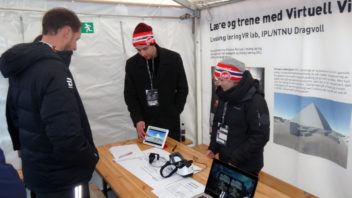
Norwegian Crown Prince Haakon tried out the mathematics app during the Ski Jumping World Cup in Trondheim in March. Photo: Experts in Teamwork
For example, one of the groups in the NTNU EiT Village “VR/AR in Learning and Training” developed an app to help 8th graders learn math. It was even tested out by Norway’s Crown Prince Haakon during the Ski Jumping World Cup in Trondheim in March. A master’s student will continue researching VR mathematics instruction.
Other groups from the EiT Village developed VR/AR applications for science instruction and for use by apprentices at Nordbohus, a home construction company.
Perhaps architects could collaborate on designing a house and experiment with moving around from room to room?
These examples illustrate how groups in physically different places can apply VR technology to projects that require demonstrating something in a near-tangible way.
Maybe city planners can get an impression of how their city would be affected by building in a certain area or eliminating a park. Trondheim municipality already has a prototype in place for this kind of VR solution.
Imagination will be the only limitation when time, funding and the will to take a bold new step fall into place.
Students and teachers are ready
This is a work in progress. Nicklas Nilsen has delivered his master’s thesis, but two new master’s students are ready to continue the work.
“The purpose of the project is to investigate the extent to which students can develop skills in collaborating through virtual collaboration. This is useful information for a university with campuses in several cities to have,” says Bjørn Sortland, head of the EiT staff.
“The virtual reality collaboration with Trondheim gives us the chance to collaborate in new ways,” says Simon McCallum at NTNU in Gjøvik.
“The goal is to make NTNU a physical centre in Norway for virtual reality,” Prasolova-Førland says.
She is involved in everything from student education and training for accidents to swimming with salmon in fish farms. At the same time, she has started her own VR network for women in Norway and will lead the Virtual Practice Site project with a grant from the Norwegian Labour and Welfare Administration The goal is to get young people into jobs with the help of VR/AR technology that includes game elements.
All this in a reality that doesn’t even exist – but that almost exists all the same.
